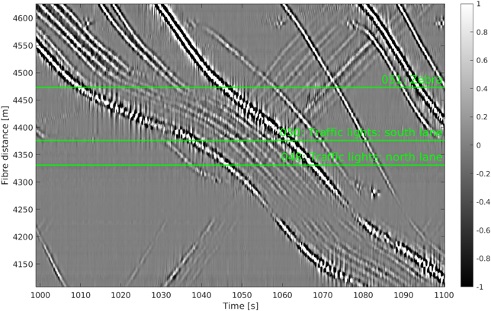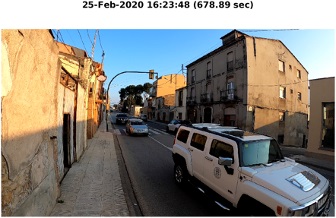
Across the world, urbanisation continues to drive an unprecedented number of people into cities. This has left many municipality transport networks buckling under the strain.
Reliable and efficient traffic flow systems have become essential for sustainable urban growth. Emissions reductions, air quality improvements and journey reliability times, are now key performance indicators for successful smart city infrastructure and transport network planning.
The trouble is, existing traffic tracking technology is fraught with shortcomings: point sensors and cameras have limited and fixed fields of view, while in-vehicle sensors that track location data lack the granular detail for concise traffic flow tracking.
Floating point data can give average waiting times at a junction, but it lacks the expediency to effectively change traffic lights in real time and directly improve vehicle flows. GPS can be affected by disrupted signal in tunnels or rural areas or simply because tracking technology is only available within a minority of vehicles.
Essentially, the critical drawback of current traffic monitoring technology is the lack of real-time transparency and data feeds that can be monitored remotely and acted upon swiftly when potential issues or congestion rises to harmful levels.

So, despite smart city spending in 2019 totalling $124 billion, further investment remains necessary to digitally augment major transport systems.
As well as fixing technology drawbacks, the other important challenge is how to deliver a fully-integrated traffic management system without rendering existing infrastructure obsolete. Solutions that can incorporate and build upon existing infrastructure - instead of rip and replace - are especially desirable.
How DAS can help
Distributed acoustic sensing (DAS) is a photonic sensing technology that essentially upgrades a city’s existing fibre optic cable to contain thousands of vibration sensors — akin to placing an army of microphones along a road.
Lasers shoot thousands of pulses of light down a cable every second. A minor proportion of this is reflected back to the DAS system and any disturbances will be picked up by the sensor. Each kind of disturbance has its own signature, therefore allowing the DAS system to tell an operator in real-time what happened, exactly where it happened and when it happened.
 By equipping the fibre cable laid alongside a road with the DAS technology, it becomes possible to track vehicle movements, determine the size of vehicles using the roads, work out where - and what type of - congestion forms, assess the state of the infrastructure and also identify unexpected works.
By equipping the fibre cable laid alongside a road with the DAS technology, it becomes possible to track vehicle movements, determine the size of vehicles using the roads, work out where - and what type of - congestion forms, assess the state of the infrastructure and also identify unexpected works.
Armed with those insights, local authorities can improve journey times and air quality through congestion management methods, be alerted to dangerous traffic queues on slip roads, get information on infrastructure usage, where motorists are jumping red lights, or trespassing, as well as protecting pipes and cables from harm.
By ‘tapping in’ to the vast fibre optic cabling infrastructure that exists in abundance in cities across the globe, DAS provides greater coverage of city infrastructure than any other technology. There’s no need to carry out extensive construction work, dig up the streets or install new fixed-point sensors or cameras.
La Bisbal d'Empordà
In February this year Fotech worked with Spanish infrastructure and engineering company Comsa, on an immersive field trial to determine how DAS could manage traffic at roundabouts and whether it could help to change the sequencing of traffic lights to improve congestion.

A trial of DAS was set up along a 5km stretch of road through open countryside, a light industrial area and the Catalonian town of La Bisbal d'Empordà, tapping into roadside fibre in a micro trench and then fibre underneath the roadside pavement in the town. The test aimed to thoroughly test the capabilities of DAS for a traffic management system and to determine the limits of its sensitivity.
Throughout the day, Fotech and Comsa measured regular traffic flows through a combination of DAS and video cameras to cross-validate the findings at specific points along the route. The trial also measured the movements of pedestrians, cyclists and the vibrations of an old stone bridge along the route.
At night, a 500m stretch of road between two roundabouts was closed so that the team could run a series of tests. These ranged from tracking different methods of braking and accelerating, as well as running simulated traffic queues. Each of the parameters was changed one by one in order to understand how much the sensors were able to measure.
While analysis of the data is still ongoing, it is already clear that DAS can be used to track the movement of vehicles in both directions without interruption along the stretch of an entire road, as well as deliver sufficient information for a sophisticated traffic management system. The test has proved DAS’s ability to determine the size of vehicles and the speed at which they travel, in addition to identifying points of congestion and the length and growth-rate of queues.
Fotech is now working to build an integrated solution that can control traffic throughout a road network, with the additional benefit of reducing emissions and increasing air quality.
Adding more value
Further to the trial in La Bisbal d'Empordà there are numerous opportunities where DAS can offer existing smart city projects a crucial extra layer of detail. Take NTT Data’s ‘safe city’ work in Las Vegas, for example.
One of this project’s prime use cases so far has been wrong-way driver detection in downtown one-way roadway segments. By gathering before-and-after data it has been possible to measure the effectiveness of roadway improvements.
 A stated future goal of the project is to explore additional ways to improve traffic management and signal timing. The reality is that DAS can play a massive role in the real-time dynamic management of traffic systems.
A stated future goal of the project is to explore additional ways to improve traffic management and signal timing. The reality is that DAS can play a massive role in the real-time dynamic management of traffic systems.
For example, if someone jumps a red light at an intersection – DAS would be able to detect this. The system could then immediately change the traffic lights in real time to hold traffic and pedestrians at other points of the intersection on a longer red light to minimise the risk of an incident caused by the car jumping the lights.
Integrating DAS with NTT Data’s safe city solution would quickly demonstrate the impact of various traffic management strategies and provide clear evidence on which to base real-time traffic management decisions at a citywide level.
Looking to the future
No single technology can provide a panacea to the challenge of urbanisation and traffic management but it’s clear that DAS offers authorities a big step forward for transport infrastructure and city networks. Not least because it builds upon the existing fibre cabling infrastructure in cities.
What trials such as the recent one in La Bisbal d'Empordà show is that DAS can make a practical difference to alleviate the strain on transport networks and provide better insight on road congestion.

ABOUT THE AUTHOR:
Stuart Large is product line director and business development at Fotech Solutions, and has spent more than 20 years in leading-edge sensor technology











